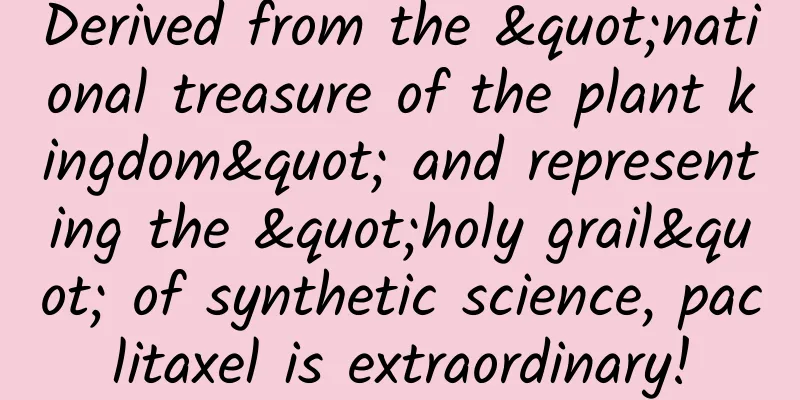Derived from the "national treasure of the plant kingdom" and representing the "holy grail" of synthetic science, paclitaxel is extraordinary!

|
Produced by: Science Popularization China Author: Denovo Producer: China Science Expo In autumn, some small red fruits often appear in gardening and bonsai. However, you may not know that they are actually the first-class protected plants of the country - Taxus chinensis. This plant is not only elegant and charming in appearance, but also the natural source of the anti-cancer drug "Taxol", which can be called a treasure in the plant world. Yew (Image source: pixabay) Paclitaxel has attracted much attention due to its unique anti-cancer mechanism. The process from its discovery to clinical application has demonstrated scientists' persistence and breakthroughs in anti-cancer technology. Why can paclitaxel fight cancer? In the late 1950s and early 1960s, in order to screen for compounds with anti-cancer activity from plants, American scientists collected more than 35,000 plant samples worldwide[7]. In 1962, botanist Arthur S. Barclay collected bark samples from Pacific yew in Washington State, USA. The samples were then sent to the chemical laboratory of the National Cancer Institute (NCI) for anti-cancer activity testing. In 1964, Mansukh C. Wani and Monroe E. Wall found that a substance extracted from yew bark showed strong cytotoxicity to certain cancer cell lines. They named it paclitaxel and analyzed its chemical structure using nuclear magnetic resonance and mass spectrometry. Structure of Paclitaxel (Image source: Document 3) In the 1970s and 1980s, scientists conducted in-depth research on the anti-cancer mechanism of paclitaxel and gradually revealed its mechanism of action, which is that its main target is tubulin in cells. Tubulin is the core component of cell microtubules and plays a vital role in cell division, material transport and cell morphology maintenance. Unlike normal cells, cancer cells continue to divide due to uncontrolled growth and show the characteristics of unlimited proliferation. Paclitaxel can inhibit the depolymerization process of microtubules by binding to the β subunit of tubulin, thereby interfering with the normal division and proliferation of cancer cells. In addition, paclitaxel can also inhibit the proliferation of cancer cells by inducing apoptosis-related pathways. Microtubule structure and staining (Image source: Wikipedia) Where is paclitaxel obtained? The dual mechanism of action of paclitaxel makes it an important drug for the treatment of various cancers, including breast cancer, lung cancer, prostate cancer, and ovarian cancer. However, this breakthrough discovery also brings huge resource challenges: how to obtain paclitaxel efficiently and sustainably? Recommended treatment options (Image source: "Expert Consensus on the Clinical Application of Taxane-Based Dose-Dense Chemotherapy in China") Each cancer patient needs about 2.5-3 grams of paclitaxel, which may not seem like much at first glance, but this dose may require a lot of yew bark to extract. According to statistics, to meet the annual treatment needs of ovarian cancer patients in the United States, more than 300,000 yew trees need to be cut down each year. However, the natural growth cycle of yew is very slow. It takes hundreds of years for a sapling to grow into a big tree. It is called the "giant panda" among plants. Faced with this challenge, organic synthesis scientists from more than 60 research teams around the world have been engaged in the research of paclitaxel since the 1980s. However, the paclitaxel molecule contains a complex eight-membered ring-six-membered ring-four-membered ring structure, which is extremely difficult to synthesize. Therefore, the synthesis of paclitaxel is also known as the "holy grail" in the field of organic total synthesis. Key time points in the development of paclitaxel (Photo source: Southern University of Science and Technology News Network) In 1994, the Elias J. Corey team at the Memorial Sloan-Kettering Cancer Center and the KC Nicolaou team at the Scripps Research Institute successively completed the total synthesis of paclitaxel (i.e., synthesizing complex organic molecules completely from scratch using simple chemical raw materials). However, their synthetic route was complicated, requiring more than 40 steps of reaction, and the yield was less than 0.01%. On this basis, scientists from the United States, Japan and China have continued to work on this over the past four decades and have developed 11 total synthesis routes for paclitaxel. It is worth mentioning that Li Chuangchuang's research team in China proposed an efficient synthesis scheme that only requires 27 steps. This scheme has become the route with the fewest synthetic steps and has greatly improved the synthesis efficiency. However, due to its high cost and low yield, total synthesis was not immediately used in industrial production. At present, the industrial production of paclitaxel mainly adopts the strategy of semi-synthesis (using complex compounds extracted from natural sources as starting materials, and then converting them into target compounds through a series of chemical reactions). The key intermediate, 10-deacetylbaccatin III, is first isolated from the branches and leaves of yew, and then paclitaxel is synthesized through four-step chemical transformation. Semi-synthesis technology greatly reduces the demand for yew bark, while increasing the yield and sustainability of paclitaxel. Solve the "bottleneck" problem However, semi-synthesis is still limited by the long growth cycle of Taxus chinensis, which makes it difficult to meet the growing clinical needs. For this reason, in recent years, scientists have shifted their research focus to more promising bioengineering technologies in order to break through this bottleneck. In 2024, Professor Lei Xiaoguang's team from Peking University and Researcher Yan Jianbin's team from the Chinese Academy of Agricultural Sciences and other domestic and foreign teams worked together to use a variety of technical means to successfully achieve the synthesis of 10-deacetylbaccatin III in tobacco, solving the long-standing "bottleneck" problem of the paclitaxel biosynthesis pathway. In addition, the Chinese government has also focused on the sustainable use of yew resources, and has established large-scale yew planting bases in Yunnan, Guangxi, Zhejiang and Northeast China, and has taken various measures to accelerate its growth. Through artificial cultivation technology, the growth cycle of yew can usually be shortened to 15-20 years, which greatly reduces the time cost required compared to natural yew, providing important support for the sustainable production of paclitaxel. At the yew planting base, researchers are guiding workers to harvest (Photo source: Guangming Online) Has paclitaxel been put into clinical use? In order for paclitaxel to be truly clinically applicable, a major problem needs to be overcome: paclitaxel is almost completely insoluble in water, which makes it difficult to use directly for intravenous injection. Early scientists dissolved paclitaxel in polyoxyethylene castor oil. Although this improved the solubility and stability of paclitaxel to a certain extent, the solvent could cause hypersensitivity reactions in patients, which could even be life-threatening in severe cases. According to statistics, the incidence of mild allergic reactions is high, and the incidence of severe hypersensitivity reactions is about 1%-2%. In order to reduce the risk, clinical practice usually requires the combined use of steroids and antihistamines for pretreatment before injection, but this problem still greatly limits the use of drugs. To solve this problem, Chinese doctor Patrick Soon-Shiong Chan successfully developed albumin-bound paclitaxel. Albumin-bound paclitaxel uses nanotechnology to combine drugs with human serum albumin, and accurately transports paclitaxel to the tumor cell stroma through albumin to kill tumor cells. This technology not only avoids allergic problems, but also allows the drug to reach the tumor site more concentratedly, with better and more precise effects. At the same time, albumin is a protein in the human body that is more easily broken down and absorbed by the body, greatly reducing side effects and making chemotherapy safer and more effective. Mechanism of action of nab-paclitaxel (Image source: Document 6) In addition to albumin-bound paclitaxel, scientists have also developed combination forms such as paclitaxel liposomes that "encapsulate paclitaxel in liposomes" and docetaxel that "has added hydrophilic groups". Each of them has unique technical characteristics and clinical application value. At present, the clinical application of paclitaxel in my country is very mature and widely used in the treatment of various cancers. Domestic pharmaceutical companies actively promote the research and development and production of paclitaxel preparations, including traditional solvent-based paclitaxel injection and albumin paclitaxel and other varieties. With the continuous improvement of production capacity and continuous advancement of technology, the market supply of paclitaxel preparations in China has become increasingly stable, not only meeting the growing clinical needs in China, but also gradually exporting to the international market. In addition, paclitaxel injection, docetaxel (docetaxel) and albumin-bound paclitaxel have been included in the "2022 Drug Catalog" issued by the National Healthcare Security Administration and the Ministry of Human Resources and Social Security, reducing the economic burden on patients and further improving the accessibility and usage rate of drugs. Paclitaxel-related drugs have been included in medical insurance (Image source: National Medical Insurance Drug Catalogue Query) Conclusion From the initial extraction from the bark of the yew tree, to full synthesis, semi-synthesis, and then to innovative preparations with albumin and liposomes as carriers, the development of paclitaxel demonstrates the unremitting efforts and technological innovation of scientists in anti-cancer research. With the breakthrough of biosynthesis technology and the improvement of production capacity, paclitaxel will bring good news to more cancer patients and inject new impetus into the anti-cancer cause. References: 1.Singla AK, Garg A, Aggarwal D. Paclitaxel and its formulations[J]. International journal of pharmaceuticals, 2002, 235(1-2): 179-192. 2.Markman M, Mekhail T M. Paclitaxel in cancer therapy[J]. Expert opinion on pharmacotherapy, 2002, 3(6): 755-766. 3.Min L, Han JC, Zhang W, et al. Strategies and lessons learned from total synthesis of taxol[J]. Chemical Reviews, 2023, 123(8): 4934-4971. 4.Jiang B, Gao L, Wang H, et al. Characterization and heterologous reconstitution of Taxus biosynthetic enzymes leading to baccatin III[J]. Science, 2024, 383(6681): 622-629. 5.Bernabeu E, Cagel M, Lagomarsino E, et al. Paclitaxel: What has been done and the challenges remain ahead[J]. International journal of pharmaceuticals, 2017, 526(1-2): 474-495. 6.Yardley D A. nab-Paclitaxel mechanisms of action and delivery[J]. Journal of Controlled Release, 2013, 170(3): 365-372. 7. Goodman, Jordan, and Vivien Walsh. The story of taxol: nature and politics in the pursuit of an anti-cancer drug. Cambridge University Press, 2001. |
<<: Fire breaks out in high-rise buildings! These safety tips can save lives →
>>: Drink more hot water when it's cold? Be careful! Exceeding this temperature may cause cancer
Recommend
Practical tips: How to increase followers on Douyin?
Recently, some people have been asking, “Why is T...
Skyworth was sued for 190 million yuan for patent infringement; Xiaomi, LeTV and other TV manufacturers are facing an avalanche of shocks
The TV market is experiencing patent "harves...
Detailed explanation of the new information about Douyin live broadcast permissions
The way to play Douyin is constantly changing, an...
The temperature drops sharply, and the mortality rate of this disease is higher in winter! How to prevent it is to do these 6 things!
A few days ago, I received such a patient, 62-yea...
Apple releases iOS/iPadOS 14.7.1: fixes Touch ID unlocking issue
iOS14.7 and iPadOS14.7 were originally planned to...
Best recommendations for Chengdu tea tasting private WeChat 2022
Private WeChat appointment arrangements for Cheng...
Datou Laoha·Starting from 0-1 in the same city, how to make a short video popular
Datou Laoha’s local account started from 0-1, how...
It’s so hot! We have air conditioning, but what about the animals?
What does the word summer remind you of? Watermel...
Urgent reminder! Don’t eat this kind of fruit on the roadside!
Summer is here It's fruit season again Especi...
Should you wash raisins before eating them? If you eat them right, they are very sweet, but if you eat them wrong, you will become very fat.
Key Points ★ Bulk raisins can be washed, but rais...
No need to wait for express delivery. Alipay launches "Send Now Pay Later" service
In the past 10 months of 2021, the country's ...
Answers to difficult questions about Xiaohongshu operation and promotion!
In view of the fact that everyone had many diffic...
Is it considered overdue if the credit card payment is made on the due date? Two points to note
Credit card payment is considered overdue on the ...
Five major subjects that a novice operator must go through!
A fresh graduate asked me: Han Li, I want to ente...
Sharing of successful cases of Guangdiantong usage experience and summary of social advertising experience
1. Social advertising helps app growth Only throu...









